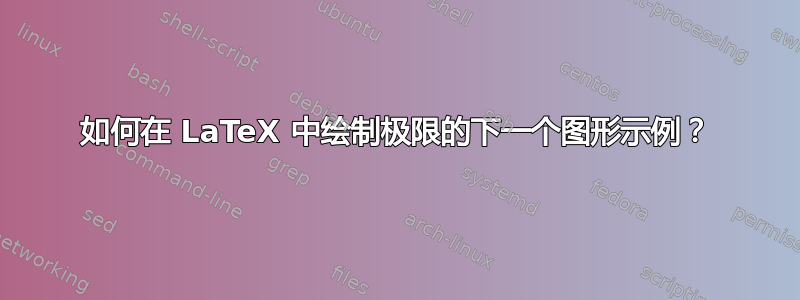
如何在 LaTeX 中绘制极限的下一个图形示例?


答案1
如果你想在LaTeX,您可以使用 TikZ 和 PGF,手册可以在这里找到:http://ctan.sharelatex.com/tex-archive/graphics/pgf/base/doc/generic/pgf/pgfmanual.pdf
PSTricks 文档可以在这里找到:https://www.tug.org/PSTricks/main.cgi?file=doc/docs
PGFplots手册可以在这里找到:http://pgfplots.sourceforge.net/pgfplots.pdf
感谢亚历山大指出该PGFplots手册的更新版本。
根据 texenthusiat 的评论,您也可以使用texdoc pgf pgfplots pstricks它TeXLive来获取手册。
要绘制抛物线,您可以执行以下操作(PGFplots):
\documentclass[tikz, convert = false]{standalone}
\usepackage{pgfplots}
\begin{document}
\begin{tikzpicture}
\begin{axis}
\addplot[blue] plot[domain = -2:4, samples = 100] (x, 3 * x * x);
\end{axis}
\end{tikzpicture}
\end{document}
\documentclass[tikz, convert = false]{standalone}
\begin{document}
\begin{tikzpicture}
\draw[blue] plot[domain = -2:4, samples = 100] ({\x}, {3 * (\x)^2});
\end{tikzpicture}
\end{document}

我不会为你画出每幅图,但这里是用两种方法画出抛物线的。
这是第一个限制示例:
\documentclass[tikz, convert = false]{standalone}
\begin{document}
\begin{tikzpicture}[xscale = 5]
\clip (1.25, 8.75) rectangle (2.8, 15);
\draw[-latex] (1.5, 9) -- (1.5, 15);
\draw[-latex] (1.5, 9) -- (2.75, 9);
\foreach \y in {9, 10, ..., 14}{
\node[left, font = \tiny] at (1.5, \y) {\y};
\draw (1.5, \y) -- +(.02, 0);
}
\foreach \x in {1.6, 1.8, ..., 2.4}{
\node[below, font = \tiny] at (\x, 9) {\x};
\draw (\x, 9) -- +(0, .08);
}
\draw[blue] plot[domain = 1.5:2.25, samples = 100] ({\x}, {3 *(\x)^2});
\draw (1.5, 12.05) -- (2.4, 12.05) node[above, blue, font = \tiny, pos = .2]
{\(y = 12.05\)};
\draw (1.5, 11.95) -- (2.4, 11.95) node[below, blue, font = \tiny, pos = .2]
{\(y = 11.95\)};
\node[font = \tiny, right, blue] at (2.2, 14) {\(y = 3x^2\)};
\end{tikzpicture}
\end{document}

因为我很无聊,不想做自己的工作:
\documentclass[convert = false, tikz]{standalone}
\usetikzlibrary{intersections}
\usetikzlibrary{backgrounds}
\begin{document}
\begin{tikzpicture}%[xscale = 2]
%\coordinate (O) at (0, 0);
\draw[-latex, name path = xline] (-.5, 0) -- (2, 0) node[right, font = \tiny]
{x};
\draw[-latex] (0, -.2) -- (0, 4.5) node[right, font = \tiny] {y};
\draw (1, .05) -- (1, -.05) node[below, font = \tiny] {1};
\draw[-stealth] (-.6, 3.9) -- (-.6, 3.1) node[pos = -.15, font = \tiny]
{$f(x)$};
\draw[-stealth] (-.6, 2.1) -- (-.6, 2.9) node[pos = -.15, font = \tiny]
{$f(x)$};
\draw[-stealth] (.6, -.3) -- (.9, -.3) node[pos = -.2, font = \tiny]
{$x$};
\draw[-stealth] (1.4, -.3) -- (1.1, -.3) node[pos = -.2, font = \tiny]
{$x$};
\foreach \y in {1, 2, 3, 4}{
\draw (.05, \y) -- (-.05, \y) node[left, font = \tiny] {\y};
}
\draw[blue!40, name path = para] plot[domain = -.1:1.3, samples = 100]
({\x}, {2 * (\x)^2 + 1});
\draw[blue!40, fill = white] (1, 3) circle[radius = .02cm];
\begin{scope}[on background layer]
\foreach \yl/\i in {2.1/1, 2.4/2, 2.55/3, 2.8/4, 2.9/5}{
\filldraw[black] (0, \yl) circle[radius = .02cm];
\path[name path global = \i] (0, \yl) -- +(2, 0);
\path[name intersections = {of = para and \i, by = P\i}];
\draw (0, \yl) -- (P\i);
\begin{pgfinterruptboundingbox}
\path[name path global = Pxl\i] (P\i) -- +(0, -5);
\end{pgfinterruptboundingbox}
\path[name intersections = {of = xline and Pxl\i, by = Xl\i}];
\draw (P\i) -- (Xl\i);
\filldraw[black] (Xl\i) circle[radius = .02cm];
}
\foreach \yu/\i in {4.1/6, 3.6/7, 3.45/8, 3.2/9, 3.1/10}{
\filldraw[black] (0, \yu) circle[radius = .02cm];
\path[name path global = \i] (0, \yu) -- +(2, 0);
\path[name intersections = {of = para and \i, by = P\i}];
\draw (0, \yu) -- (P\i);
\begin{pgfinterruptboundingbox}
\path[name path global = Pxu\i] (P\i) -- +(0, -5);
\end{pgfinterruptboundingbox}
\path[name intersections = {of = xline and Pxu\i, by = Xu\i}];
\draw (P\i) -- (Xu\i);
\filldraw[black] (Xu\i) circle[radius = .02cm];
}
\end{scope}
\end{tikzpicture}
\end{document}




